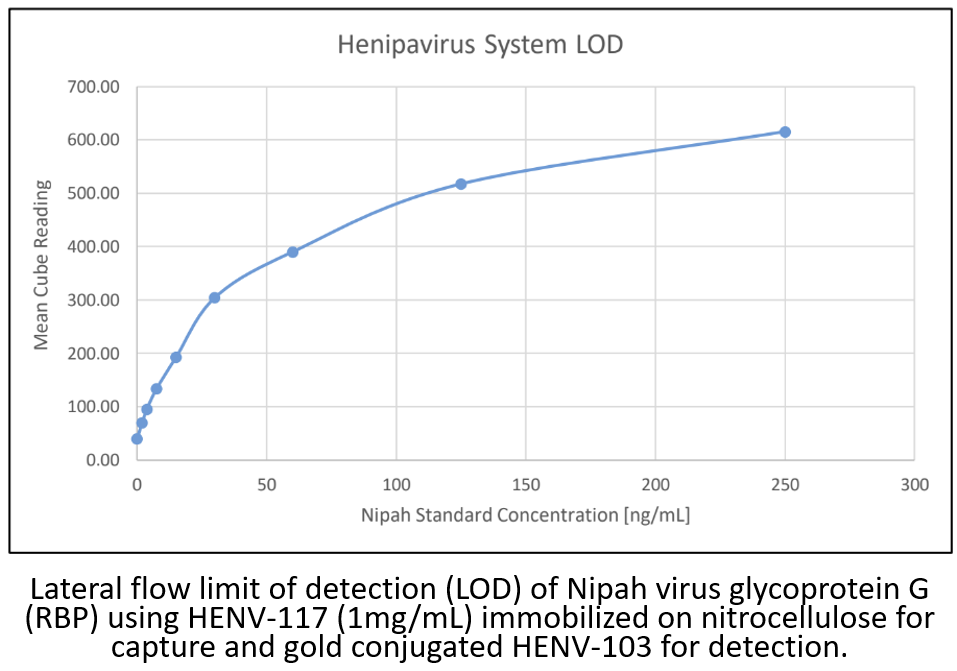Anti-Henipavirus [Clone HENV-117] — Purified No Carrier Protein
Anti-Henipavirus [Clone HENV-117] — Purified No Carrier Protein
Product No.: LT576
- -
- -
Product No.LT576 Clone HENV-117 Target Henipavirus Product Type Recombinant Monoclonal Antibody Alternate Names Hendra virus, HeV, Nipah virus, NiV Isotype Human IgG1 Applications ELISA , FC , Lateral Flow , N |
Data
- -
- -
Antibody DetailsProduct DetailsReactive Species Henipavirus ⋅ Hendra virus ⋅ Nipah Virus Expression Host HEK-293 Cells Immunogen HENV-117 was isolated from circulating B cells of an individual exposed to equine HeV vaccine. Product Concentration ≥1.0 mg/ml Purity ≥90% monomer by analytical SEC and SDS-Page Formulation This recombinant monoclonal antibody is aseptically packaged and formulated in 0.01 M phosphate buffered saline (150 mM NaCl) PBS pH 7.2 - 7.4 with no carrier protein, potassium, calcium or preservatives added. Due to inherent biochemical properties of antibodies, certain products may be prone to precipitation over time. Precipitation may be removed by aseptic centrifugation and/or filtration. Product Preparation Recombinant antibodies are manufactured in an animal free facility using only in vitro protein free cell culture techniques and are purified by a multi-step process including the use of protein A or G to assure extremely low levels of endotoxins, leachable protein A or aggregates. Storage and Handling This antibody may be stored sterile as received at 2-8°C for up to one month. For longer term storage, aseptically aliquot in working volumes without diluting and store at ≤ -70°C. Avoid Repeated Freeze Thaw Cycles. Country of Origin USA Shipping Standard Overnight on Blue Ice. Applications and Recommended Usage? Quality Tested by Leinco Lateral Flow Additional Applications Reported In Literature ? FC N Each investigator should determine their own optimal working dilution for specific applications. See directions on lot specific datasheets, as information may periodically change. DescriptionDescriptionSpecificity HENV-117 activity is directed against the receptor-binding domain of receptor binding protein (RBP).
HENV-117, has shown to neutralizes HeV, NiVM, or NiVB with exceptional potency according to the literature and HENV-117 maps to the receptor-binding domain of HeV-RBP and displays a receptor-blocking phenotype. Binding decreases substantially in the presence of ephrin-B2, indicating HENV-117 neutralizes by blocking binding of virus to host cells. nsEM mapping shows that HENV-117 mimics ephrin-B2 binding. 5
Background Henipavirus spp. are enveloped, single-stranded RNA viruses in the family Paramyxovirus1. Five species have been identified, two of which, Hendra virus (HeV) and Nipah virus (NiV), are highly virulent emerging pathogens with high case-fatality ratios. The other three species, Cedar virus, Ghanaian bat virus, and Mojiang virus are not known to cause human disease. Pteropid bats are the reservoir host. HeV is transmitted by direct contact with infected horses, their fluids, or tissues1. Horses are infected by exposure to pteropid bats. NiV is transmitted by contact with infected pigs or bats and person-to-person. Both HeV and NiV cause severe influenza-like illness that can progress to encephalitis.
Antigen Distribution Henipavirus RBP is an envelope glycoprotein. Matched Pair This antibody has been tested in lateral flow assays. The best matched pair is HENV-117 (Capture)/HENV-103 (Detection). Research Area Henipavirus . Infectious Disease . Viral . IVD Raw Material . Nipah References & Citations1. Shoemaker T, Choi MJ. Chapter 4: Travel-Related Infectious Diseases, Henipaviruses. In: Brunette GW, Nemhauser JB, eds. 2020 CDC Yellow Book. CDC; National Center for Emerging and Zoonotic Infectious Diseases (NCEZID), Division of Global Migration and Quarantine (DGMQ), Link Text
2. Aguilar HC, Ataman ZA, Aspericueta V, et al. J Biol Chem. 284(3):1628-1635. 2009. 3. Mire CE, Chan YP, Borisevich V, et al. J Infect Dis. 221(Suppl 4):S471-S479. 2020. 4. Zhu Z, Dimitrov AS, Bossart KN, et al. J Virol. 80(2):891-899. 2006. 5. Doyle MP, Kose N, Borisevich V, et al. Cell Rep. Aug 31;36(9):109628. 2021. Technical ProtocolsCertificate of Analysis |
Related Products
- -
- -
Formats Available
 Products are for research use only. Not for use in diagnostic or therapeutic procedures.
Products are for research use only. Not for use in diagnostic or therapeutic procedures.



